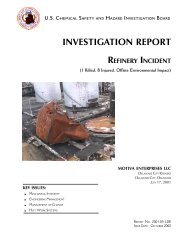Little General Store Propane Explosion - US Chemical Safety and ...
Little General Store Propane Explosion - US Chemical Safety and ...
Little General Store Propane Explosion - US Chemical Safety and ...
Create successful ePaper yourself
Turn your PDF publications into a flip-book with our unique Google optimized e-Paper software.
<strong>Little</strong> <strong>General</strong> <strong>Store</strong> September 2008<br />
Ferrellgas filled the tank at <strong>Little</strong> <strong>General</strong> <strong>Store</strong> about 14 times per year; in the 10 years that Ferrellgas<br />
owned the tank, drivers would have performed more than 100 pre-fill inspections. The CSB interviewed<br />
several drivers who filled the <strong>Little</strong> <strong>General</strong> tank <strong>and</strong> performed the required inspections. All drivers<br />
stated that they believed the tank was permitted to be directly against the building’s exterior back wall<br />
either because it was “gr<strong>and</strong>fathered,” 29 the installer had received a variance from local authorities, 30 or<br />
there was no other place to install the tank.<br />
2) Ferrellgas Installation Review<br />
The Ferrellgas Installation Review (FIR) 31 is a visual inspection of the installation at a customer’s site.<br />
The FIR includes the same topics as the driver’s pre-fill inspection; however, the inspector records the<br />
results either on a form or h<strong>and</strong>held computer. The service center receives the results of the FIR, records<br />
deficiencies, <strong>and</strong> dispatches service technicians to repair noted problems.<br />
Ferrellgas performed two FIRs on the <strong>Little</strong> <strong>General</strong> <strong>Store</strong> installation in 2000, four years after acquiring<br />
the tank (Appendix A). These inspections were two months apart; neither inspector noted the placement<br />
of the tank on the form. 32 Both inspectors told CSB that they could remember neither the inspections nor<br />
the reasons for not reporting the tank’s placement in the FIR.<br />
29<br />
They believed that the tank installation predated the 10-foot clearance requirement, <strong>and</strong> was permitted to remain<br />
next to the building under some previous set of rules.<br />
30<br />
Local authorities issue formal waivers from code requirements such as the tank placement distances, which are<br />
known as variances. Ferrellgas training materials reference the possibility of obtaining a variance from local<br />
authorities; however, a variance was not issued for the placement of the tank at <strong>Little</strong> <strong>General</strong>.<br />
31<br />
Ferrellgas called this inspection program the FIR during the time it owned the incident tank. The review has been<br />
renamed <strong>and</strong> is now called the Product Installation Review. The methodology for inspection has not changed.<br />
32<br />
Checking the location of an installed tank is step one in the FIR procedures, which states that tanks that do not<br />
meet the 10-foot placement requirement must have a written variance from local authorities.<br />
33









